

Movies, morning announcements, letter templates, posters, lessons & activities for teachers, administrators, staff, students, parents.
Measure your plastic use and impact
Overview Slides
MATH Lessons
Games!

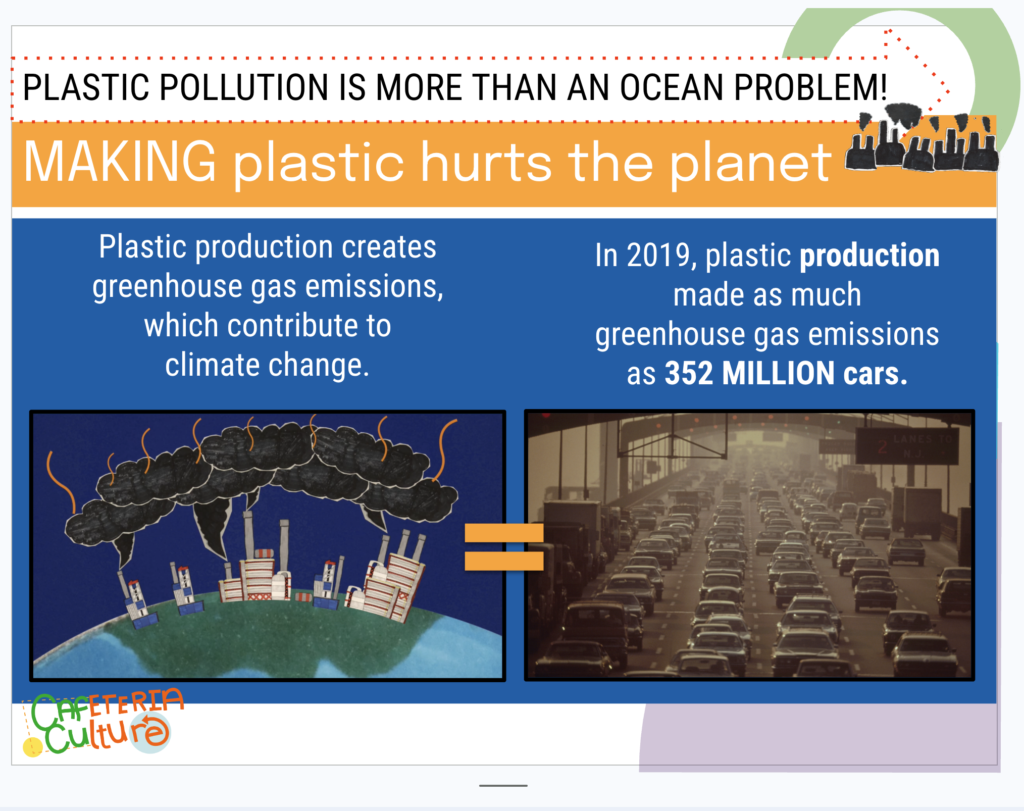
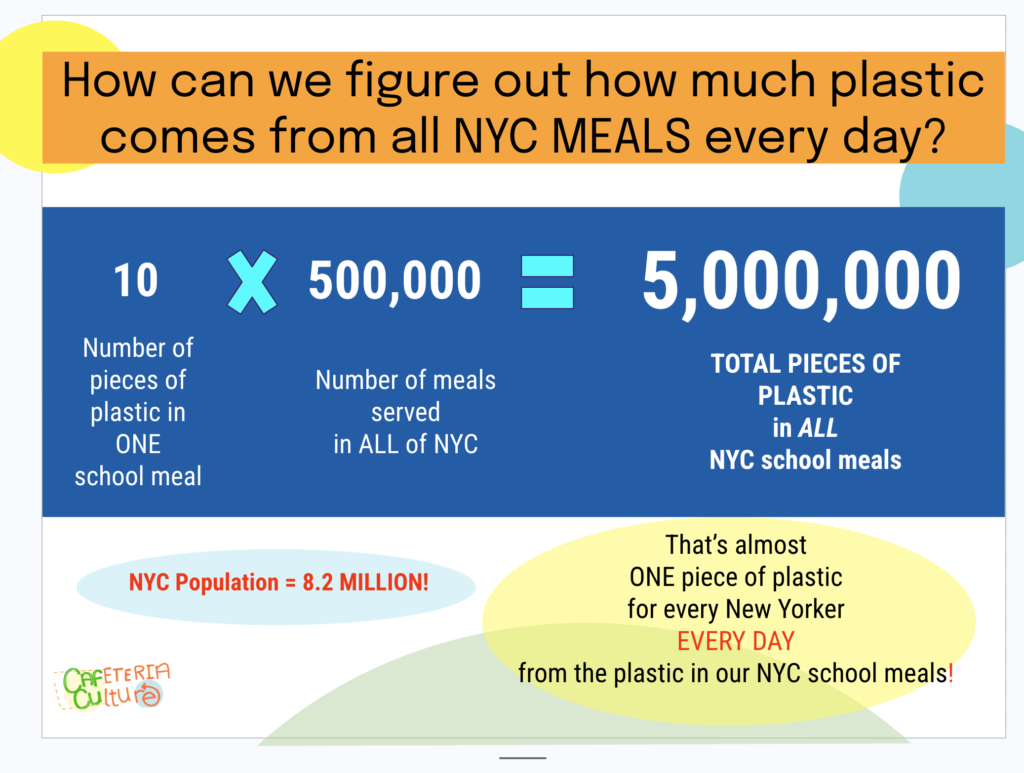

Show in the classroom, cafeteria, assembly, after school, or club!
Print these or create your own!



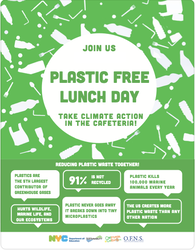
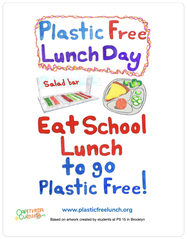
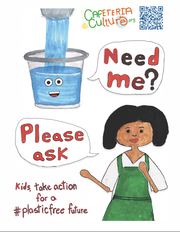
For High School Students
For College Students
The world is awash in toxic and polluting single-use plastics made from hazardous chemicals that are contaminating our ecosystems, our communities and our bodies. The US creates more plastic waste than any other nation and it never goes away. It degrades into tiny microplastics and then nanoplastics. Scientists have found microplastics in the deepest parts of the ocean, and in our soil, food, water and air, and in our bodies.
380 million metric tons of plastic are produced each year.
The US plastic recycling rate has dropped below 6%!
US Schools serve 7.35 billion meals annually. Those meals are packed with non-biodegradable single-use plastics (SUPs) that make a significant contribution to the US plastic waste stream and the staggering global plastic pollution problem. Most of those SUPs end up in a landfill or environment.
Plastic Free Lunch Day provides students an opportunity to learn about plastic pollution and take meaningful plastic-reduction action. One plastic free day leads to another and creates a vision and actionable ideas to move forward in a just and sustainable way.
Each year, we produce over 350 million metric tons of plastic; more than 40% of this is single-use plastic–plastic packaging and foodware that is used for less than 20 minutes. Because plastic is not recyclable, most discarded plastic is sent to landfills or “leaks” into the natural environment.
Plastic does not biodegrade. Instead it breaks or fragments into small particles called microplastics and then into smaller particles called nanoplastics. Because plastic is made from fossil fuels and thousands of persistent toxic chemicals, they transfer thousands of migrating chemicals into our food during use. After disposal and fragmentation, plastic particles carry and distribute these toxic chemicals to every inch of the globe.
Scientists have found micro and nanoplastics in our digestive tract, deep in our lung tissue, in the placenta, and circulating in our blood. Nanoplastics deliver thousands of toxic chemicals directly to the organs, tissues, and cells in our bodies. We now face the public health crisis of our time.,
School cafeterias serve over 40 million meals a day and make a large contribution to the plastic waste stream. School cafeterias are a great place to begin reducing single-use plastics, while also protecting the health of our students–society’s most vulnerable members. Plastic free lunch day is a first step that results in useful photos and data but, most importantly, it shows everyone that food dispensing and eating does not require plastic!
Read entire article->
excerpt:
The life cycle of plastic begins underground, where oil and gas are extracted from deep below the surface of the planet. These fossil fuels are then refined in facilities, using extreme temperatures and significant amount of water and energy, where they are transformed into pellets that are eventually melted and molded into things like water bottles, packaging, garbage bags and clothes.
And the widespread use of single-use plastic — the stuff we use once and then throw away — is only made worse by its disposal. Plastics do not break down once they’re thrown into nature. And, alarmingly, only around 9% plastic in the United States is actually recycled, according to the Environmental Protection Agency — even the stuff you specifically threw into the recycle bin.
What you might not realize is this isn’t just a pollution problem. It’s a climate problem. And by the time we start talking about recycling, the damage is already done.
continue reading ->
Adapted from NPR July 2019 – for 5th grade
ADAPTED FROM NPR JULY 2019 – FOR 5TH GRADE ->
“The key message that people should take away is that the plastics crisis is a climate crisis hiding in plain sight,” Muffett says.
ORIGINAL ARTICLE
THE WASHINGTON POST, MAY 4, 2022
Entire artilce_>
excerpt:
“The plastics industry must stop lying to the public about plastics recycling. It does not work, it never will work, and no amount of false advertising will change that,” said Judith Enck, who heads Beyond Plastics and served as a regional EPA administrator during the Obama administration. “Instead, we need consumer brand companies and governments to adopt policies that reduce the production, usage and disposal of plastics.”
Though plastics use fell in the early days of the pandemic, consumption has surged along with economic activity. Meanwhile, plastic waste exports — which the authors said are counted toward recycling numbers without proof — have plummeted in the wake of import bans by countries such as China and Turkey.
Entire article ->
excerpt:
At 42m metric tons of plastic waste a year, the US generates more waste than all EU countries combined.
The advent of cheap, versatile plastics has created “a global scale deluge of plastic waste seemingly everywhere we look”, the report states, with the US a leading contributor of disposable plastics that ends up entangling and choking marine life, harming ecosystems and bringing harmful pollution up through the food chain.
Entire article ->
excerpt:
The cocktail of chemical pollution that pervades the planet now threatens the stability of global ecosystems upon which humanity depends, scientists have said.
Plastics are of particularly high concern, they said, along with 350,000 synthetic chemicals including pesticides, industrial compounds and antibiotics. Plastic pollution is now found from the summit of Mount Everest to the deepest oceans, and some toxic chemicals, such as PCBs, are long-lasting and widespread.


